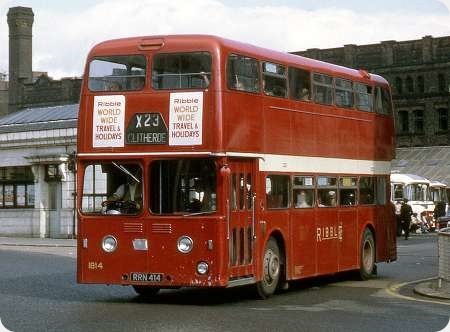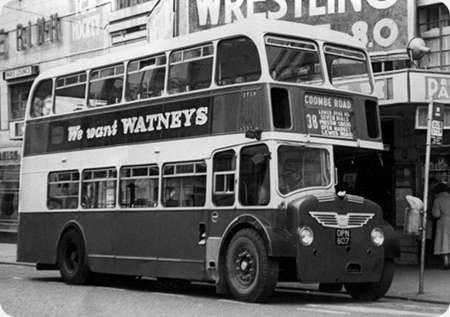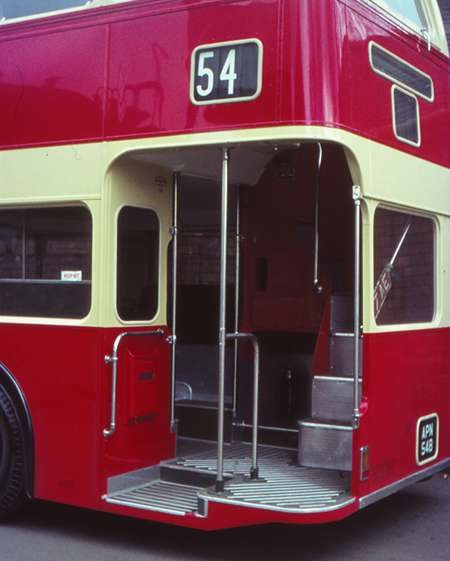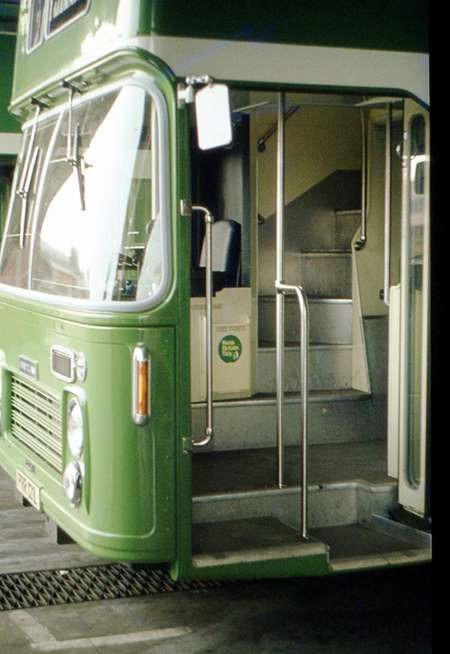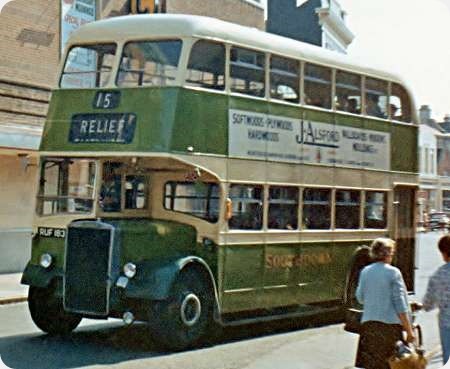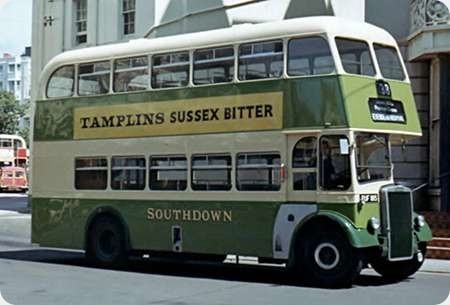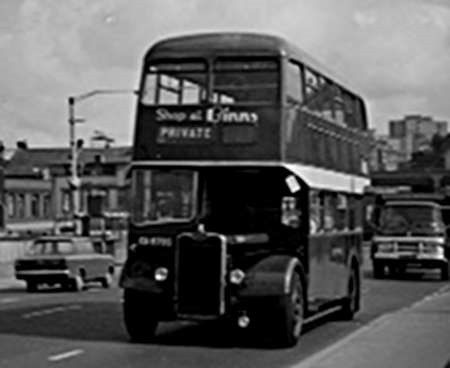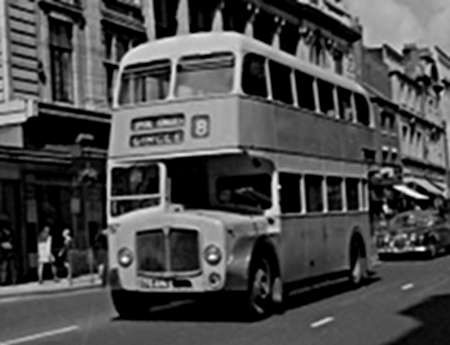Ribble – Leyland Atlantean – RRN 414 – 1814
Ribble Motor Services
1962
Leyland Atlantean PDR1/1
Weymann L39/33F
Seen in August 1969 in less than pristine condition leaving Manchester’s Lower Mosley Street Bus Station (often confusing us slow witted southerners by appearing on bus destination blinds as “Manchester LMS”) is Ribble 1814, the last of a batch of fourteen Weymann bodied lowbridge Atlanteans on the original PDR1/1 chassis. This was fitted with a straight rear axle which required the lower deck to incorporate a step to gain access to the uplifted rear part of the saloon. The corresponding rear section of the upper saloon also had to be raised, so that a side gangway of the traditional lowbridge variety was employed in that area, though this was located on the nearside of the vehicle (front engined lowbridge double deckers had the gangway on the offside to avoid fouling the passenger entrance). The 1801 -1814 lowbridge Atlanteans were the last examples of the PDR1/1 chassis to be bought by Ribble.
Another OBP page showing one of these Atlanteans may be found here:- At this link
and a comprehensive article by Neville Mercer on Lower Mosley Street is here:- Lower Mosley Street – Article
Photograph and Copy contributed by Roger Cox
13/03/18 – 06:06
I think by 1962, the bodywork on these lowbridge Atlanteans had improved somewhat on the original examples which came out in 1959. The single skinned fibreglass domes (which tended to crack) had been replaced by double skinned ones, the interior face being a sort of brilliant white plastic which seemed to resist yellowing very well. Other small improvements to the interior trim and panelling made the general ambience feel noticeably better and I quite liked to travel on the later ones. I believe both Ribble and PMT got very long service lives out of them in spite of the problems they were supposed to have had.
Chris Barker
17/03/18 – 07:15
Looks like someone tried to prize off the Ribble fleet nameplate on the front panel.
Perhaps her less than pristine condition is down to her being due her seven year Check/Overhaul.
Cyril Aston
18/03/18 – 06:47
Ribble got very good service from these some lasting into the eighties
Chris Hough
18/03/18 – 06:47
Quite a sad photo, I can’t remember which particular bus it was, but had a trip on one of this batch when brand new on the X23 from LMS. I suppose I haven’t worn any better than the bus! Personally I enjoyed riding on the lowbridge Atlanteans. PMT used them on the Stoke-Stafford service which like the Ribble services gave them a good chance to open up. Travelling in the rear upstairs was quite smooth, I suppose the lower height lowered the centre of gravity, resulting in a better ride.
Andrew Gosling
07/05/18 – 07:13
PMT certainly got their moneys worth out of their 105 lowbridge Atlanteans. A lot depended on the Depot. Frank Ling who was Resident Engineer at Longton Depot achieved phenomenal engine mileages out his Atlantean fleet by carefully and diligently looking after them. recollection is that he had 4 spare vehicles for a PVR of 58 so not a lot of spare capacity there. Mind you, Frank also managed to run quite successfully a sizeable fleet of Albion Aberdonian single deckers which again other Depots failed to do so. Memory fades but I’m sure that some batches of PMT’s Atlanteans also had a plastic finish to the inside of the front domes.
Ian Wild
19/07/18 – 07:13
Stafford garage had a duty on the 10 service which I occasionally worked for my rest day. The Atlantean would probably be 909 and occasional 910 these buses belonged to Hanley garage and were serviced by them. They were a pleasure to drive and were both quite fast. Happy days !!
Michael Crofts
27/11/19 – 08:47
With regards to PMT Stafford garage I would add that both 909 and 910 were the resident Atlanteans and they were serviced by Stoke garage, not Hanley. They were indeed fine buses.
Leekensian
26/01/21 – 06:12
I remember the first time I travelled on one of these as a ten year old and not being able to see out of the front windows because the sill-level was so high.
What were the designers thinking of?
Philip Smithies
27/01/21 – 06:13
Philip S – A simple answer to your question – saving money. Shallow windows cost less than deeper ones. Even in those days 60 or more years ago, financial considerations were very important, especially to a commercial organisation like the BET Group.
Nigel Frampton
10/11/21 – 06:36
I joined British Airways Motor Transport Dept in June 1976′ Part of my very varied duties included operating the PDR1/1 Leyland Atlanteans to and from the British Airways Terminal 3 operation to The Victoria BA Terminus. ps, (no power steering on these Atlanteans). Several of us also operated the Leyland Mastiff airside tractor units pulling the 100 odd passenger articulated trailers. Maximum concentration of course winding the latter around the confines of airside roads and aircraft stands. In contrast we also transported flight deck and cabin crew in various coaches and Ford Granada cars etc. A super job that we just took for granted at the time.
James
Quick links to the - Comments Page - Contact Page - Home Page
